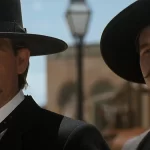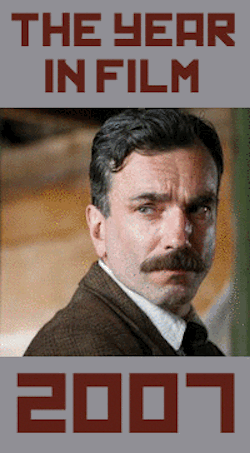The Last Vermeer: Paint by Numbers, by David Bax

Dan Friedkin’s directorial debut The Last Vermeer is a case study in how individual elements in filmmaking and performance can elevate what would otherwise be a soggy and tepid product. The most valuable example herein is the stately cinematography of Remi Adefarasin, who was once nominated for an Oscar for Elizabeth and also shot handsome-looking titles like Sliding Doors and Match Point. With a deft interplay of warm and cool colors and the occasional Kamiński-esque hot spot, you could describe Adefarasin’s contributions as painterly, though he doesn’t attempt to actually recreate the look of a Vermeer the way Eduardo Serra did in 2003’s Girl with a Pearl Earring. The Last Vermeer is too beholden to tropes to stick long in the memory but such pleasant touches at least make the viewing experience enjoyable.
The Last Vermeer dramatizes the investigation and trial of Han van Meegeren (Guy Pearce), a real life Dutch painter-turned-art dealer who was accused of selling paintings–possibly confiscated from Jewish families–to the Nazis. One of these, Johannes Vermeer’s Christ with the Adulteress, was sold to Hermann Göring himself for the equivalent of $6.75 million in today’s money. Claes Bang plays the fictionalized Captain Joseph Piller, an officer charged with uncovering the whereabouts of ill-gotten Dutch artworks lost in the fog of war.
Alongside the Australian Pearce (playing a stock effeminate villain type) and the Danish Bang (convincing as an intellectual, less so as a badass), The Last Vermeer has a stuffed roster of international character actors. Luxembourg’s Vicky Krieps plays Bang’s assistant. Germany’s August Diehl plays a rival investigator. And the all-time great Welsh scowler Karl Johnson plays the crotchety attorney brought out of retirement to take on the thankless task of defending van Meegeren in court.
Adapted by a team of writers from a book by Jonathan Lopez, The Last Vermeer approaches the feel of a throwback, turning this true story of political scandal in the art world into a kind of old-fashioned detective yarn. Piller performs muscular interrogations while sexy women sigh things like “I suppose he was in love with me” in between long, dramatic cigarette drags.
If only Friedkin could have sustained that tone. Instead, he and the screenplay force the film into other modes. In an impromptu jailbreak sequence that seems intended to serve the same function as a Red Bull in the middle of a long, solo drive at night, The Last Vermeer suddenly becomes a thriller. And then, in the final act, it transforms into a courtroom drama, quite possibly the most boring thing a movie can be.
There are interesting questions floating around in The Last Vermeer. How far can we go in judging people who did what they had to in order to survive? And how far ought we go in applauding someone like Piller, who occasionally has base and petty motivations for doing what is clearly the right thing? Along with the cast and photography, though, these are just adornments that distract us, for a time, from the film’s stale predictability.



























